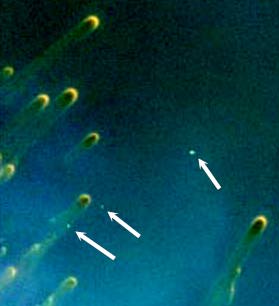The Helix Nebula is shown in the Hubble Space Telescope image below.
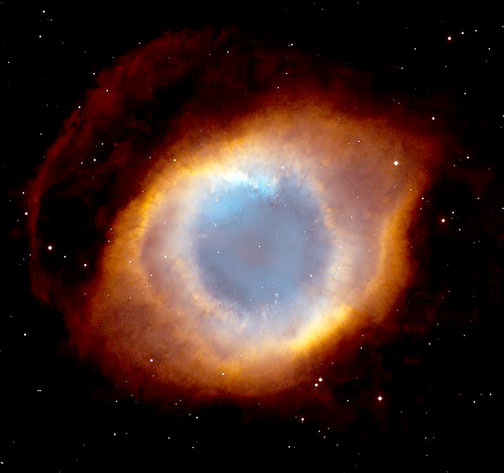
Note the small white point of at the very center of this image. I believe that is a ball-of-light and is the remains of the earlier core of the star.
The Ball-of-Light Particle Model leads me to believe that the structure of a star is different from the traditional model of stars. A graphic below shows the major portions of a star according to The Ball-of-Light Particle Model.
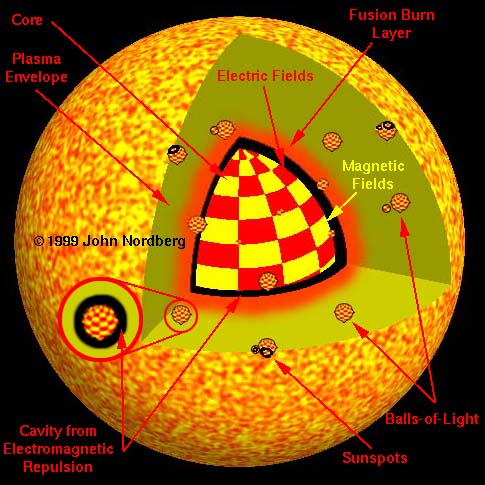
The Ball-of-Light Particle Model predicts the core of a star is a single elementary particle. It is surrounded by a mostly empty cavity. The cavity is created by the powerful electromagnetic fields on the surface of the core. These forces push away the outer plasma envelope. Outside of this void is the plasma envelope.
A believe most planetary nebulae are caused by a large object -- such as a planet -- spiraling into the star. Below is an image of a large solid planet spiraling into a star.
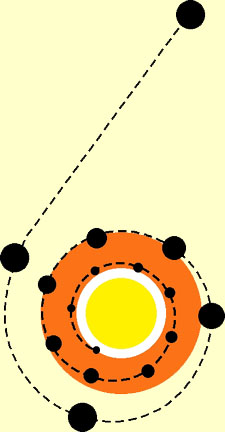
If the large object did not spiral in like this, but instead went straight into the star's core, I believe a bipolar planetary nebula, a nova or a supernova with a pulsar would occur instead. I believe this is part of the reason Ansae are formed. See also, A Solar Impact.
As the object spirals into the star, its close proximity to the plasma layer will have two initial effects, and later a third effect.
First, the object's mass will be quickly eroded by the heat of the star. By definition, this type of an event occurs between a star that is substantially more massive than the incoming object. The erosion of the object is demonstrated in the graphic above by its diminishing size.
Second, as the object spirals in -- just above the plasma layer -- the plasma will be gravitationally attracted to the object. It will create an eruption of plasma off the surface of the star like a rooster-tail of water behind a water skier.
The following graphic simulates what you might see as the you follow the object skimming over the surface of the star.
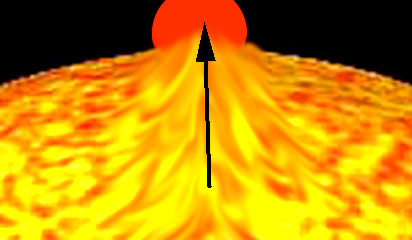
The arrow indicates that the object is moving away from you. This graphic is not as good as I would like. It sort of looks like the arrow indicates the object is popping out of the star. That is not what I want to represent, so I apologize. Anyway, in another of my attempts at artwork, below is a side view of an object spiraling into a star and kicking up a rooster tail of plasma.
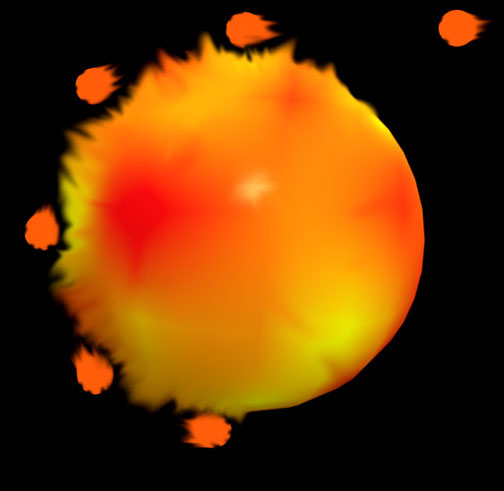
In this example, the mass of the incoming object is large enough, and the spiraling lasts long enough, so that the object sucks away almost all of the plasma surrounding the core of the star and flings it into space.
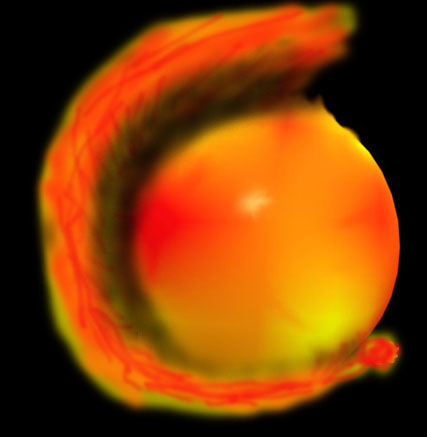
So to recap, first, the object's mass is eroded away, and second, the plasma surrounding the core is flung out into space.
The third effect has to do with the core.
The Ball-of-Light Particle Model predicts that the core of a star is a massive elementary particle. On the surface of the core of stable star are a large quantity of electromagnetic waves moving in harmonic patterns. These harmonic waves of electric and magnetic fields would be highly disrupted by a massive particle spiraling into the star and flinging the surrounding plasma into space. I believe that the plasma layer around most stellar cores acts to protect and insulate the core in a way. If the core is bared, as in a white dwarf, then it is much more at risk of being destabilized by an impacting object. The plasma layer acts as a buffer, or a shield for the core.
The spiraling in of the massive object will create gravitational waves. The spiraling out of the plasma will create massive electromagnetic waves. Both types of waves, gravitational and electromagnetic, will induce new waves on the surface of the core of the star. This can cause the star to decay in any number of decay modes. If the spiraling in of the object occurs in a plane, then I believe the star will erupt in a bipolar planetary nebula like Eta Carinae. In the case of the Helix Nebula, I believe the spiraling of the object formed a three-dimensional tube. I try to show this in the graphic below.
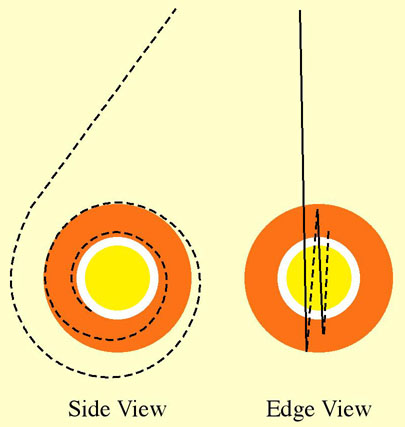
In effect, because the spiral did not occur in a flat enough plane, I believe the core of the Helix Nebula decayed in a more explosive spherical pattern rather than in a split decay mode.
Finally, I believe that as the core decayed, before the more explosive final decay mode, the massive, induced, electric, magnetic, and gravitational waves on the core, created very large balls-of-light that pealed off the core and were flung out into space with the plasma from the plasma envelope. I believe this is the root cause of sunspots, so I will duplicate a graphic I have on my sunspot page here. (See also, QuickTime Animation of Two Comets Hitting the Sun)
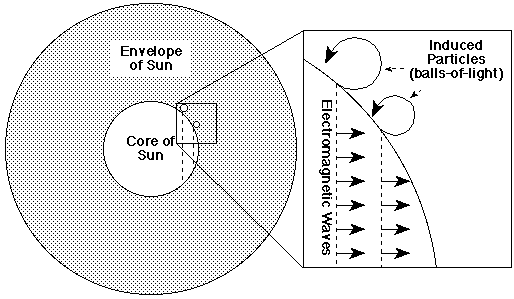
See also, Eta Carinae.
As these massive, induced balls-of-light were flung out from the core star in the Helix Nebula, they too started decaying. Close-up images of these "cometary knots" have been imaged by the Hubble Space Telescope.
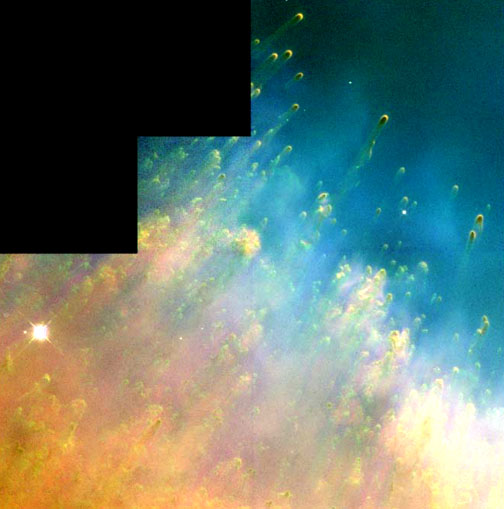
I believe these decaying balls-of-light are:
Examples of decaying balls-of-light, and possible stable balls-of-light -- indicated by arrows -- can be seen in the following image. Some of these bright points might be background stars. Another explanation is that they are balls-of-light explosively decaying -- where the explosions are caught on the image. Obviously, follow up images could create a time-lapse that would clear up such questions. I do not know of any follow up images of these decaying balls-of-light in the Helix Nebula that would clarify the issue.
